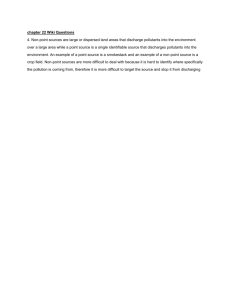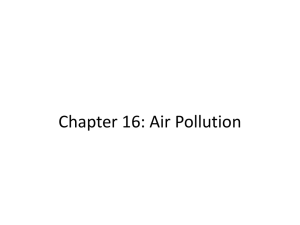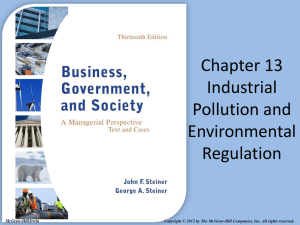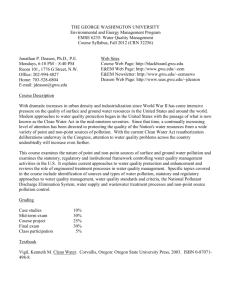5.1 Nature of Pollution PPT
advertisement
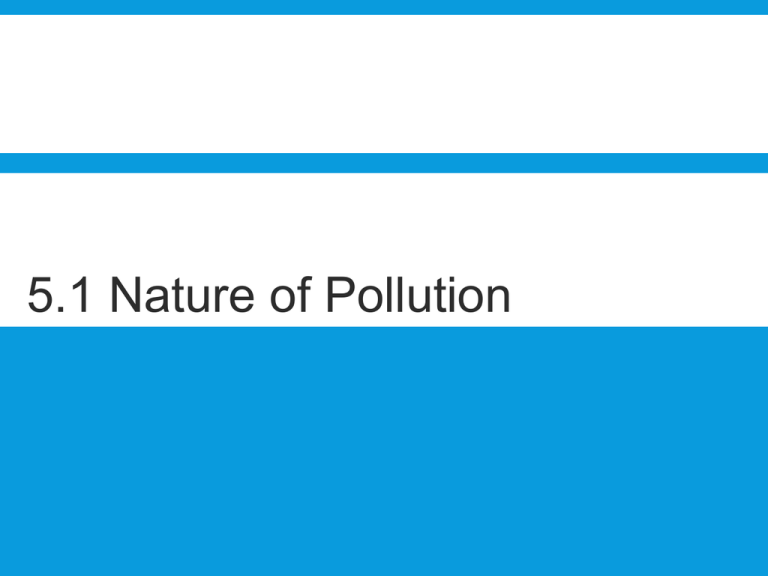
5.1 Nature of Pollution Sub-subtopics 5.1.1 Define the term pollution. 5.1.2 Distinguish between the terms point source pollution and non-point source pollution, and outline the challenges they present for management. 5.1.3 State the major sources of pollutants. 5.1.1 Pollution “the addition to the biosphere of a substance or an agent (such as heat) by human activity, at a rate greater than that at which it can be rendered harmless by the environment.” – Rutherford, pg. 276 ● 3.1.1 Examples of Pollution Gases ● CO2? ●Ozone (O3)? ● Liquids ●Solids ●Noise ●Light ●Heat ● 5.1.2 Point Source Pollution Pollution from an easily recognizable, single site Chernobyl (26 April, 1986) Bhopal, India (2-3 December, 1984) Tailpipe of a car (multiple point sources can act as a non-point source) Easy to manage/regulate Identifiable source (factory chimney, waste disposal pipe, oil tanker, etc.) Identifiable culprit (factory, house, drilling platform, etc.) 5.1.2 Non-point Source Pollution http://lab.visual-logic.com/wp-content/uploads/2010/02/image.png Pollution released from numerous, widely dispersed sites Chemical fertilizers Neighborhoods/cities Runoff Difficult to manage/regulate Who is the culprit? More widespread laws difficult to enforce Air pollution spreads hundreds of kilometers Sources and Effects http://www.nature.nps.gov/air/aqbasics/images/AQBasicSources.gif 5.1.3 Major Pollutants(from Rutherford, table 15.1, pg 277) MAJOR SOURCE Combustion of fossil fuels Domestic waste Industrial waste POLLUTANT EFFECTS ●Carbon dioxide CO2 ●Greenhouse gas; climate change ●Sulfur dioxide SO2 ●Acid deposition; respiratory problems ●Nitrogen oxides NOX ●Respiratory infections, eye irritation, smog ●Photochemical smog ●Damages plants, eye irritation, respiratory problems ●Carbon monoxide CO ●Suffocation (binds w/ hemoglobin in red blood cell) ●Organic waste (food & sewage) ●Eutrophication; water-borne diseases ●Waste paper ●Landfill; deforestation ●Plastics (containers & packaging) ●Landfill; derived from oil ●Glass ●Manufacturing energy; landfill (recyclable) ●Tins ●Landfill (recyclable) ●Heavy metals (Hg, Pb, Cd, etc.) ●Poisoning ●Fluorides ●Poisoning ●Heat ●Reduces oxygen solubility (BOD) ●Lead ●Disabilities in children; poisoning ●Acids ●Corrosive ●Nitrates ●Eutrophication Agricultural waste ●Organic waste ●Pesticides ●Eutrophication; spread diseases ●Biomagnification; bioaccumulation 5.1.3 AIR Pollutants – EU Korea & the U.S. Retrieved on 03-11-2011 from: http://eng.me.go.kr/content.do?me thod=moveContent&menuCode=p ol_cha_air_sta_emi_volume 5.1.3 Major Pollutants – AIR INDOOR Retrieved 03-11-2011 from: http://www.ebtron.com/IAQ_Basics/ebtron_IAQ_Basics_Dillution.htm Retrieved on 03-11-2011 from: http://www.environment.nsw.gov.au/images/wa ter/09085landscape.gif 5.1.3 Major Pollutants - WATER 5.1.3 Major Pollutants - LAND Retrieved on 03-11-2011 from: http://visual.merriam-webster.com/images/earth/environment/land-pollution.jpg



